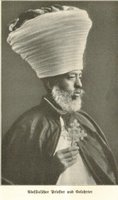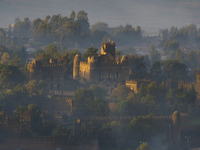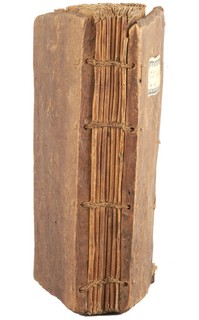
His Imperial Majesty Haile Selassie the First, Emperor of Ethiopia, King of Kings, Elect of God, Conquering Lion of the Tribe of Judah, 225th Consecutive Ruler of the Solomonic Dynasty.
Girmawi Kedamawi Haile Selassie, Neguse Negest Ze Etiyopiya, Tseyum Egziabher, Moa Anbessa Ze Imnegede Yehuda, 225gna Negassi Ze Solomonawi

Emperor Haile Selassie's Uniform Riband Bars 1974 and the Emperor in his later years (from Ethiopia Reaches Her Hand Unto God by Copley and forward by Prince Ermias Sahle Selassie 1988)

Emperor Haile Selassie was a world wide traveler here seen with the Japanese in 1956. I would like to point out that the media usually prints his name as Selassie. This is a big error. The name Haile Selassie is one single name. Henceforth through out this section Haile Selassie will be printed the Ethiopian way, that is the correct name. Since this is a throne name too (or baptismal name) there is no last name or so-called ancestral name associated with Haile Selassie. Teferi is his given name and his father's name is Mekonnen, which is his father's given first name. It sounds complicated because in reality it is very simple. In Ethiopia only first names exist and only recently have people began to use the given names of their grandparents as an ancestral name

The Emperor in 1955 by Sandford

This photo was taken by the Swiss Sven Tillge-Rasmussen in 1930 in the book Abessinien I Krig. The author was from a group of Red Cross regiment provided by the Swiss during the invasion of Ethiopia by the Fascists in 1936.

Ras Teferi in 1925 taken by Powell, a traveler throughout East Africa.

Ras Teferi in 1925 taken by Powell. The throne is now at the National Museum in Addis Abeba. Empress Zewditu authorized Ras Teferi as Prince regent and heir apparent to the throne of the Conquering Lion of the Tribe of Judah.

Ras Teferi just before his coronation as Haile Selassie I Emperor (Atse) of Ethiopia. (Pankhurst frontipiece. Economic History of Ethiopia).

Emperor Haile Selassie before Fascist invasion in 1935 from a book by Princess Asfa Yilma. It is suggested by the author that this is his favorite portrait.

Haile Selassie (1935) in coronation garb. Emperors had live lions and the tiger indicates foreign influence. Westerners visited Ethiopia during Fascist saber-rattling!(Ernest Work 1935)

Regent Ras Teferi and Empress Zewditu on the Throne of Ethiopia (1930's) from Frank Hayter's Gold of Ethiopia,1936. Frank was a gold prospector eager to make money in Ethiopia and was known to hunt wildgame. The scepter (Sendek in Amharic) in Ras Teferi's hands appears to be of foreign design. Ethiopian Scepter is a simple staff.

A portrait for the American people by Ras Teferi in 1927 (The Last of Free Africa, MacCreagh, 1928). It is apparent from the different portraits that Ras Teferi was careful not to duplicate his wardrobe for different visitors to the Empire.

Emperor Haile Selassie around 1930. Reuters reprisentative Dunckley was in Addis to check out the country of Haile Selassie and Ethiopia before the Fascist invasion.

Emperor Haile Selassie as Ras Teferi about 1926. The period before the fascist invasion was visited by many journalists and travelors and so-called Explorers to see the (so they thought) the last of free Abyssinia. Regardless Haile Selassie took this opportunity to make friends. James Baum had previously titled the book Savage Abyssinia but in in his later edition titled it Unknown Ethiopia.

This photo by Bergsma from Rainbow Empire 1932. He was a surgeon at Teferi Mekonnen Hospital at the American Mission in Addis Abeba under the auspices of the United Presbyterian Church of North America.

Official portrait of Haile Selassie I from "For God and Country" by Della Hanson, an Adventist teacher and wife of an Adventist school developer at Akaki. She was asked by Haile Selassie to coordinate the Palace receptions and banquets as well as other assignments before during and after the Fascist barbarism.

Della Hanson and JanHoy before 1958 during a trip. Mrs Hanson worked in the palace for years and witnessed the fascist entry into Addis Ababa and evacuation of JanHoy to England and Geneva. She was there when JanHoy also came back from exile on May 5th.

Della Hanson snapped this when Haile Selassie was visiting the Adventist operated and owned Zewditu Metasebia Hospital which was adjacent to the Jubilee Palace (pre-1958).

Well trained Palace servants that Della Hanson directed on orders of Haile Selassie. She worked for 14 years directing every facet of events at the Jubilee Palace. The uniforms were colored green and red and yellow buttons.

Lielt Tsehai,Asfa Wossen, Leul Mekonnen and Haile Selassie. Behind HS I is probably Hakim Martin Workineh as he was the rep in England.(1964 Mosley)

from Haile Selassie The Conquering Lion Mosley 1964

from Haile Selassie The Conquering Lion Mosley 1964

from Haile Selassie The Conquering Lion Mosley 1964

from Haile Selassie The Conquering Lion Mosley 1964

Teferi Mekonnen at 5 and 7 years old with relatives Ras Imru and Teferi Belew

Teferi Mekonnen 11 years old

Official portrait of Haile Selassie as Representative at The League of Nations (Indiana University)

The Royal Family. Leul Mekonnen, The Emperor, Crown Prince Asfa Wossen and Princesses (Sandford 1955. The Lion of Judah shall Prevail)

Ras Teferi, Lij Iyasu and Ras Biru during their good times as feudal chiefs.

Mrs Sandford's picture of the royal family and palace ground pool about 1945

Haile Selassie in exile in England

Emperor Haile Selassie inspecting the troops in Addis Abeba about 1945. Sitted to his right is Prince Mekonnen who was always together on trips and official functions. It is said that Leul Mekonnen was the favorite son of the emperor.

The Palace Body Guards of the Jubilee Palace in 1945 called Kebur Zebegna in Amharic. They may be barefoot but they wore lion's mane on their heads! The body guards went through several changes, from traditional swordsmen to modern soldiers.

Some of Emperor Haile Selassie's trusted Rases in 1945. Click on photo for identity of these Rases!

The emperor was not known as a good horseman like Emperor Yohannes or Lij Iyasu. He was delicate short but full of dignity. He is known to release an aura that was very intimidating. It is said that one conspirator confessed his motive to asassinate him as he approached the emperor on the throne. Photo Emperor inspecting troops in Addis Abeba. (from Mittelholzer's Abessinien Flug, Zurich, 1934)

(from Mittelholzer's Abessinien Flug, Zurich, 1934)

The major event in 1930 was the transformation of Teferi Mekonnen from Ras to King to Emperor. He was Ras Teferi in early 1930, then crowned Negus Teferi on April 8th and by November 1930 became Emperor (or Qedamawi Haile Selassie Neguse Negest Ze Etiyopiya). In this photo from General Virgin's book The Abyssinia I Knew (1936), the Emperor and Empress Menen (Itegue) are shown in their coronation robes.

Emperor Haile Selassie in yet another uniform. Photo from General Virgin's book The Abyssinia I Knew (1936).

Negus Teferi days before his coronation (Schwab 1979)

Words of Wisdom and Prophecy for the League members in 1936 (Schwab 1979)

Haile Selassie at JFK funeral

Haile Selassie I in his office in 1945















